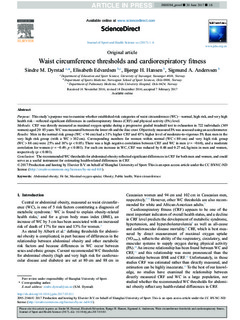Waist circumference thresholds and cardiorespiratory fitness
Journal article, Peer reviewed
Published version
Permanent lenke
http://hdl.handle.net/11250/2493876Utgivelsesdato
2017-04Metadata
Vis full innførselSamlinger
Originalversjon
Waist circumference thresholds and cardiorespiratory fitness. Journal of Sport and Health Science, 10.1016/j.jshs.2017.03.011Sammendrag
Purpose
This study's purpose was to examine whether established risk categories of waist circumference (WC)—normal, high risk, and very high health risk—reflected significant differences in cardiorespiratory fitness (CRF) and physical activity (PA) level.
Methods
CRF was directly measured as maximal oxygen uptake during a progressive graded treadmill test to exhaustion in 722 individuals (349 women) aged 20–85 years. WC was measured between the lower rib and the iliac crest. Objectively measured PA was assessed using an accelerometer.
Results
Men in the normal risk group (WC < 94 cm) had a 31% higher CRF and 43% higher level of moderate-to-vigorous PA than men in the very high risk group (with a WC > 102 cm). Corresponding numbers for women within normal (WC < 80 cm) and very high risk group (WC > 88 cm) were 25% and 18% (p <0.05). There was a high negative correlation between CRF and WC in men (r = −0.68), and a moderate correlation for women (r = −0.49; p <0.001). For each cm increase in WC, CRF was reduced by 0.48 and 0.27 mL/kg/min in men and women, respectively (p <0.001).
Conclusion
The recommended WC thresholds for abdominal obesity reflected significant differences in CRF for both men and women, and could serve as a useful instrument for estimating health-related differences in CRF.

